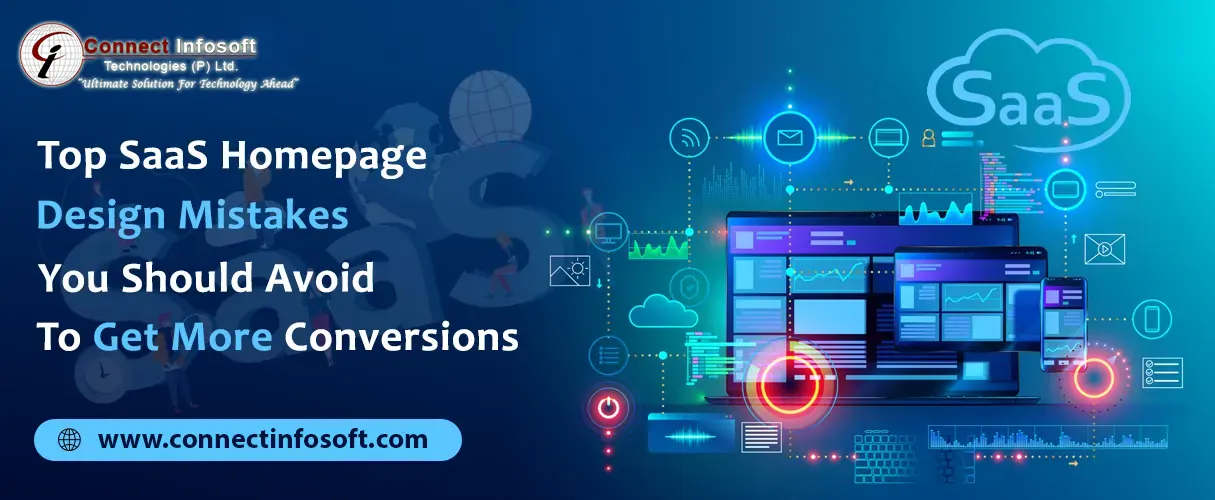Top SaaS Homepage Design Mistakes You Should Avoid to Get More Conversions

Software as a Service (SaaS) has become increasingly popular, with businesses relying on these cloud-based solutions for their software needs. The success of a SaaS company heavily relies on its website, particularly the homepage, as it serves as the virtual storefront and the first point of contact for potential customers. A well-designed homepage can significantly impact conversions and drive business growth. However, there are several common design mistakes that SaaS companies make, inadvertently hindering their conversion rates.
We will explore some of these mistakes and provide insights on how to avoid them to maximize your SaaS homepage's potential.
1. Lack of Clear Value Proposition:
One of the most critical mistakes SaaS companies make is failing to communicate their value proposition effectively. Users need to understand how your product solves their problems and why they should choose your SaaS solution over your competitors. Ensure that your homepage clearly highlights the unique benefits and features of your product with concise and compelling copy. Use headlines, subheadings, and bullet points to communicate your value proposition quickly and succinctly.
2. Overwhelming or Cluttered Design:
A cluttered homepage design can overwhelm visitors and make it difficult for them to find the information they need. Avoid clutter by using ample white space, clean typography, and a well-organized layout. Use clear and visually appealing visuals, such as high-quality images and videos, to engage visitors without overpowering the page. Remember, a clutter-free design helps visitors focus on your core message and call-to-action (CTA).
3. Lack of Clear Call-to-Action (CTA):
Without a clear and prominent CTA, visitors may be unsure of what action to take next, resulting in missed conversions. Make sure your CTA stands out and is strategically placed on the homepage. Use contrasting colors, compelling copy, and clear instructions to guide users toward the desired action, whether it's signing up for a free trial, requesting a demo, or making a purchase. Additionally, limit the number of CTAs on the homepage to avoid overwhelming visitors with too many options.
4. Complex Navigation:
A confusing or convoluted navigation structure can frustrate visitors and lead to high bounce rates. Keep your navigation simple and intuitive, with clear labels that accurately represent the content and functionality of each page. Use a logical hierarchy and consider implementing dropdown menus or a search function to help users find what they're looking for quickly. Remember to prioritize the most important pages or sections, such as pricing, features, and customer testimonials, in the navigation menu.
5. Lack of Social Proof:
Testimonials, case studies, and customer success stories are powerful tools to establish trust and credibility. Including social proof on your homepage can significantly impact conversion rates. Showcase positive reviews, testimonials, and any awards or recognition your SaaS product has received. Incorporate logos of well-known clients or industry partners to further strengthen your brand's credibility. Social proof helps potential customers feel more confident in choosing your SaaS solution.
6. Absence of Responsive Design:
In today's mobile-driven world, a responsive design is no longer optional – it's a necessity. Many users access websites from mobile devices, and if your homepage is not optimized for various screen sizes, you risk losing potential customers. Ensure that your design is responsive and adapts seamlessly to different devices and screen resolutions. Test your homepage on different devices to ensure a consistent and user-friendly experience across all platforms.
7. Slow Loading Speed:
In an era where instant gratification is the norm, a slow-loading homepage can be detrimental to your conversion rates. Visitors are likely to abandon a website if it takes too long to load. Optimize your homepage by compressing and resizing images, leveraging browser caching, and minifying CSS and JavaScript files. Regularly monitor your website's loading speed and make necessary optimizations to provide a fast and seamless browsing experience.
Conclusion:
Designing an effective SaaS homepage requires careful attention to detail and avoiding common mistakes that can hinder conversion rates. By addressing the issues mentioned above, you can enhance your homepage's user experience, effectively communicate your value proposition, and ultimately increase conversions. Remember to prioritize clear communication, intuitive navigation, social proof, and a responsive design. Continuously monitor and optimize your homepage to adapt to changing user preferences and ensure a seamless experience for your potential customers. By avoiding these mistakes and implementing best practices, you can create a compelling SaaS homepage that drives conversions and propels your business toward success.


